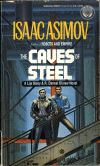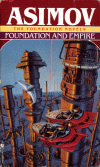This is the first in a series of the Robot Novels by Isaac Asimov. The main characters in this book are Elijah “Lije” Baley, a plainclothes cop, and R. Daneel Olivaw, a humaniform robot. The story takes place on futuristic Earth, approximately 3021 AD. Earth is heavily populated and most cities are mostly underground and interconnected. The major Cities such as New York are referred to with the capital C because of their massive size. New York City’s population is somewhere around 20million and Earth’s population tops 8 billion. Some people criticize Asimov by because Earth’s population will top 8 billion by 2020 according to many calculations. We have to remember that this is just a fiction book written in the 1950’s after all. These massive Cities are essentially enclosed underground and agoraphobia is common among most of the population.
Until recently almost all robot labor had been restricted to the Outside, for farming and transporting goods. There is a strong anti-robot sentiment among most humans and Lije Baley is no exception. He fears and hates robots. Recently, robots have been slowly begun to take menial jobs from humans. The main fear is that eventually robots will take over everyone’s job and leave none for people. Lije Baily is called to the Commisioner’s office and given a special task. He must investigate the murder of a prominent Spacer with the assistance of R. Daneel Olivaw, a humaniform robot.
The are 50 Spacer worlds originally colonized by humans. Their population is only around 5.5 billion, but their technology and military power far surpass humans. Their immune systems are far weaker than those on Earth because their new worlds are essentially germ free. They are unwilling to risk infection, so have insisted that Earth cooperate by allowing R. Daneel Olivaw to assist with the investigation.
I won’t go into any details about the investigation, but Asimov keeps you guessing all along the way. The culture of futuristic Earth is very interesting, and the interaction between Lije and Daneel offers plenty of philosophical situations to be explored. It is very interesting to see how their relationship develops throughout the series. Overall, I’d have to say that R. Daneel Olivaw is my favorite character in the Robot & Foundation series. He definitely plays one of the most important roles throughout all of the novels. Of course a Robot Novel wouldn’t be complete without The Three Laws of Robotics, which are weaved nicely into the plot. By the end of the book you can see how Asimov is working to connect the Robot series to the Foundation series.



Really Nice and crisp review man, Thanks a lot.
After reading “prelude to foundation” I decided to read the entire series in a chronological order and it is really nice experience. So far I finished “Complete Robot” and “caves of steel” its like as if building a house brick by brick and you have no idea how the shape of the house will be and you can feel it as everything is slowly taking shape.
Anybody who is new to the world created by Isaac Asimov I strongly recommend read it in chronological order.
cheers!
Glad you’re enjoying reading in chronological order. Have you read previously in order of publication? Please come back and share your thoughts on the other books as you finish them.